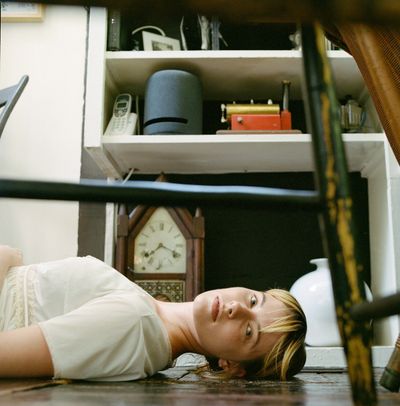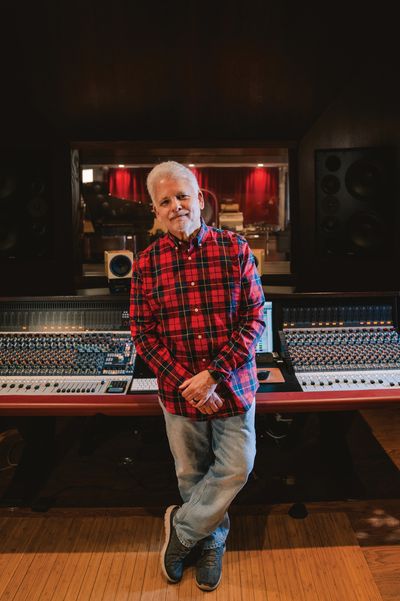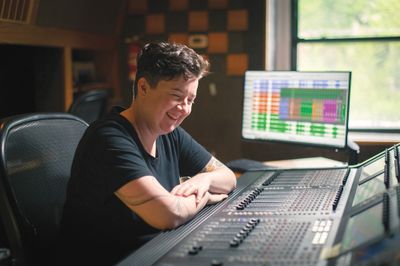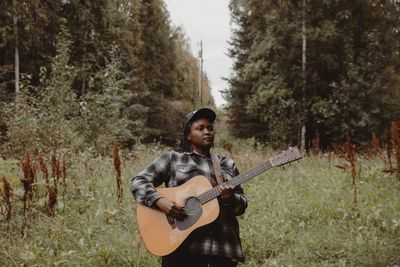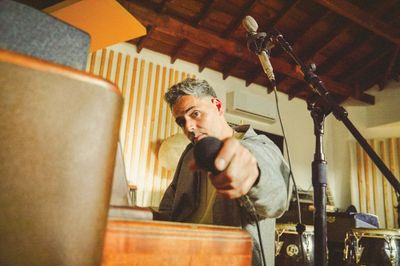A few years back he built his dream studio, Higher Power Recording, in upstate New York in a decommissioned church, only to return quickly to Brooklyn where he is now the producer in demand. I caught up with Bryce — tall, bearded and always very focused — in Trout Recording in Park Slope — 3rd Avenue off Flatbush Avenue to you and me. Zelda the very large wünder dog, an Akita huskie, sat peaceably under the large Neve console as the interview began.
How did you start working in studios and stuff, or was it through a band?
Well, when it came time to pick a career or a college, I went to SUNY Fredonia and enrolled in their Sound Recording Technology program there and wound up in a studio by choice. Dave Fridmann came out of there. Dave Moulton, who went to Berklee, wound up being the head of the Tonmeister Studies [Sound Recording Technology] when I was there. It was an interesting program — you spent two years as a music major, did some physics, acoustics, electronics, computer science, like a mélange of stuff, as well as five or ten hours in a recording studio.
When you graduated from Fredonia did things start to happen right away for you?
I had a friend who ran an instrument cartage company. I was schlepping gear for studio musicians. So I had my head in and out of lot of recording studios in New York for about six months. One day I was schlepping Steve Holly's [Wings drummer] drum kit around, and he mentioned that a new studio was opening up and they needed some bodies there to work. It was a place called Sound On Sound. It was an excellent facility to be starting out at just because the equipment was world class but there wasn't a lot of work going on there. The head engineer of the studio was this guy, Mike McMackin. He worked with Bitch Magnet, Codeine, and a bunch of other people later on, but at that point he was getting his chops together as well. The facility was down most nights and weekends and the owner Dave Amlen was generous enough to let all his staff experiment with recordings. I had a bunch of friends that I had gone to college with who were living close by, so I did a lot of experimental jazz recordings with them. In the evenings I was also able to work with a guy named Steve Kilby from the Church on a project he was working on with Donnette Thayer from Game Theory. The project was called Hex. There were also a lot of talented engineers who came in and out of that place: Alec Head, Joe Ferla, Ed Stasium, Paul Hammingson, Lenny Kaye. I got to peer over the shoulder of an awful lot of world-class engineers and producers.
Who's your biggest influence in your approach to recording?
I was influenced by Ferla and Head in terms of their simplistic approach to recording — doing a lot of work with mic placements and not much work with EQ. I was inspired by [Steve] Lillywhite [Tape Op #93], [Daniel] Lanois [Tape Op #37 & #127] — by their earlier sort of reckless disregard for convention, which I thought was kind of fun.
What do you think was your first break?
That Hex project. It got me a position in a studio called Baby Monster — a little bit of a slummy kind of studio compared to Sound On Sound in terms of equipment that was there and the rate. It was a great opportunity for me because it was a couple of blocks away from the Knitting Factory. John Zorn had just dragged everybody in the Knitting Factory to do a record he was working on. Doing ten records with Elliot Sharp over the course of three years, as well as with Zeena Parkins, Marc Ribot, David Shea and Christian Markley. A lot of eclectic interesting downtown composers like Guy Klusevic. All these composers and musicians didn't work in kind of a conventional way. Elliot would come in with charts with hieroglyphics on them. There was so much improvisation. For me it was really exciting — a great way to experiment and get your chops up. I would get thrown the oddest instruments in the world. Like slabs were one thing Elliot recorded a lot — they looked like literally pizza pans with strings strung across them. Anthony Coleman would come up with the most weirdly distorted keyboard sounds. It would seem very caustic but then you could get them to work in context to make a recording very, very exciting. Everybody was pushing the envelope of their sound.
So from that how did you start meeting the underground alternative rock bands like Pavement and The Lemonheads?
There was this woman, Janet Billig, who was managing Nirvana, The Lemonheads, and was trying to... I wasn't sure how heavily she was pursuing Pavement, but she was at least advising Pavement — helping Pavement out during the recording process. She had sent Evan [Dando] down to Baby Monster to do a couple of B-sides with me and had recommended that Pavement use me to mix Crooked Rain. So I did one mix for Pavement and they kind of liked what I did. And I ended up mixing the whole record for them. Once Crooked Rain came out I had a name at least.
They liked it so much you ended up dong three records with them...
I ended up mixing Wowie Zowie with them and tracking and mixing Brighten the Corners with them. When they came to me with Crooked Rain there were no track sheets — there was no documentation. There was no leader between anything. There was line hum on the lead vocal and stuff. There were certainly a lot of technical problems with that recording. I guess I recognized the energy that was on that tape, and just tried to ignore those technical problems — fix them the best I could. But I specifically remember working on stuff for hours and then going, 'The drums are not going to get any better than they are right now.' I couldn't push them to the fidelity I thought was conventionally necessary at the time. But it wound up being sort of a blessing — it wound up having a unique sound. There wasn't really anything homogenous about it. And I think part of it was the ropy recording techniques. It's also the groove of Pavement, which was always pretty incredible. I remember when I was working on Brighten the Corners, they were jamming out — we were recording at Mitch Easter's [Tape Op #21] Fideletorium in North Carolina. They were upstairs in this small room, and I was downstairs in this other living room space. So I couldn't see them, but I had all the mics up, kind of tweaking up the sound. They just had this very weird and interesting groove that they all did together. I guess Westy was keeping it all together. Everybody was pulling against him in an interesting and exciting way and it felt sort of bouncy and lively.
Did you find yourself trying to give direction to the band, or was spont- aneity what that band was all about?
I definitely feel like Malkmus was driving the sort of production ship through most of that. He would come up with an idea, and I would be like the executioner. He would say he wanted stuff to sound like Odyssey and Oracle. Throw out a few ideas. And I would kind of pick that up and push it along in a direction so that it actually became that. It was really a stream of consciousness way of working that we all kind of got. I felt at the time I was making orchestration decision about guitar parts and stuff. But Steve would pick up the ball. I would pick up the ball. We had a symbiotic relationship. It didn't feel like we would get to a crossroad and then fight about where to go. There was a pretty clear path and we were all going there.
And when you were working with Mitch Easter was it the same way?
It was Mitch's recording studio, and Mitch was a very helpful guy down at his studio. To navigate somebody else's studio would be very tedious. He stayed in the periphery pretty well when I was there. I tracked Brighten the Corners for about two weeks and I had to come back to New York to work with Bettie Serveert on their new record. So he spent another week down there recording some guitars. He was a fun guy to hang out with.
Was it Steve's idea to go down to his studio?
I think Mitch was wooing him. Steve definitely liked to mix it up when he was recording. He would always try to go to another recording facility to figure his band in a different way. Brighten the Corners was probably the first proper Pavement record where the whole band played a lot of the songs together. I remember when we were sequencing Crooked Rain, Steve turned to [Mark] Ibold and said, "You'd better listen to these parts because you're going to have to play them live." [laughter] I recorded a bunch of vocals and played some piano on Crooked Rain — but the lion's share of the recordings were done by the time I got my hands on them — by a guy named Mark Venitzia. A lot of the vocals that we cut on Crooked Rain and Wowie Zowie were pretty much improvised. I mean he had some ideas jotted down on a piece of paper, and would work off of them. For the most part, it was first take material. Sometimes we would take a second pass. It was not really a concern for performance but for lyrical content. It's certainly a very exciting way of working in this day and age of pop music.
What I admire about your recordings is that there is a lot of exuberance and it's natural sounding.
Well, I kind of approach most recording with a respect for the acoustical event that's going on. I try to keep engineering out of it as much as possible. I have a good grasp of what the frequency responses of mics are and what the mic pres I'm using can do to it. What I'm out to do is to accurately reproduce that event. I feel that's more interesting than all the processing in the world. I guess I do get bored of hearing the same outboard kind of effects approach to stuff.
So no gated reverb finds its way in?
No, it does as an effect or a statement, not as a matter of course. I personally think gated reverb is a sound that can enhance and make you feel in a certain way. I don't really feel that one should be strictly limited to not use effects. But one shouldn't feel obligated to use it all the time. It's just what textures are going to work, and what will make the song more musical and more exciting and get the artist's vision through. I guess I must be imposing my aesthetic on most of the stuff I'm working with, but I generally find myself working with people who have a similar aesthetic.
Do you have any favorite techniques or mics that you like to use on a kit, or does it always vary?
I definitely like rotating stuff. The other day I picked up a set of tracks I recorded about ten months ago. At that point I was using these Lomo 19A19 large diaphragm condenser microphones. Inside they use a C12 capsule, so they pretty much sound like a C12. They're a little bit more cardioid, more directional. I thought they sounded really kick-ass. But about five months ago, I kind of got bored with that and was working with combining a ribbon and a small diaphragm condenser. A Coles 4038 and a 451. I started with a 4038 and the 19A19, but the two colors were so similar it was almost redundant, whereas this 451 and the 4038 had all this spectrum to work with. I really do like the midrange that the cymbals get with a ribbon microphone. But there is something very satisfying about the crack that you get with a small condenser microphone. I'm now using a B&O ribbon microphone for overheads. I kind of frame my kit around my overhead's sound. I'll use a large diaphragm condenser microphone on the kick drum if I can. It kind of depends on how much rattling around there is going in terms of whether or not I can put a tunnel up, or whether or not there is a lot of cymbal leakage. How the tone of the kick drum is. Sometimes if you're using a single headed kick drum, it's just too fast. A large diaphragm condenser gives you too much high frequency information, and it all sounds very scooped. Then I'll stick a D12, or a D112, or something as conventional as that on the kick drum as well. I was listening to some tracks from that guy that does the Ween stuff, and he was using an RE20 on the beater side of the kick drum. I was digging that for a while. I kind of get bored with any one method of recording, so I try to rotate my mics. Sometimes it's by choice, or I have somebody's microphone for six months and I'm just using it, and then all of sudden they want it back.
For guitars you kind of get the quintessential 'alt-rock' guitar sound.
I use a 58 most of the time for guitars to start with, and then I move away from that only if the sound of the amplifier, or the guitar, necessitates that. It does fit very neatly into most mixes to use a 58. I can cut it without compression or EQ and that's always nice. If I have the luxury of sticking up a second microphone, I'll probably 'cop the Albini' and put a ribbon microphone off axis, or semi on axis, to give it a little depth. I can sometimes carry that track all the way through the mix, but it winds up getting thrown to the wayside if there are more than two or three guitars in the scene. Because it eats up so much space with that additional depth, it's superfluous and almost kind of makes stuff sound too smutty and murky.
With vocals, you get so many intimate performances. How do you get the singer relaxed?
I usually have a deep relationship with the singers I'm working with. I definitely try to figure out where they're coming from artistically. I do put a lot of energy in trying to understand what's motivating them so that they're confident that I'm sensitive to what they're trying to do. When I'm giving them direction it's coming from someone who sat with them and told them what they're trying to do musically, how they're trying to effect the piece of music by their vocal. When I work with Evan Dando, it's horrible when we work on stuff, working meticulously. My best performances from Evan are when he's absolutely in outer space and not thinking about anything. He spends a lot of time performing his music before he records it — it's sort of printed in his brain in a certain way. He can get to that spot by being relaxed and not thinking. There are a lot of singers where I have to work line by line, or section by section, to get a performance out. You have to be able to shift gears — and you have to be able to be bold enough to realize that the work method that you're using at the time is horseshit. You've got to come back and reassess the approach. I dispense the stream of consciousness approach with Evan often when the line by line approach is going to work better or more flatteringly for a piece of music. But you just have to see what he's giving and see where he's going. And sometimes I'll work a whole day with him going line by line on a performance, and we will be both at each other's throat. And then in two weeks later he'll come back and knock it dead in one pass. But I still have faith with the fact that we spent that horrible day, you know going over stuff, is what yielded that performance.
Your approach for microphones for singers, does it vary as much as it does for drums?
I guess I'm more concerned about comfort and performance than I am about the sonic impact. I can take a recording of a vocal on a SM58, or some crappy recording — like for instance a lot of the Crooked Rain recordings have line hum on them. They literally had "gneeeeeee" going on behind them. What microphone he used for that doesn't matter. It was absolute shit, but the performance was so great you just wanted to work with the sound that you had. Bring the vocal forward in the song and let it carry the song. I'll get a little anal with a microphone sometimes, if I have that luxury. But a lot of times I want an artist to feel comfortable with his environment, and create an environment that's going to give me the performance that I need. That's more important to me than the sonic impact of the microphone itself. I was working with Phish, Trey Anastasio was more comfortable with the mic he was using while he was touring, which was a Neumann KMS150 — a hand held microphone that Neumann makes. His voice definitely sounded better on a U87. His performance was not happening when he had headphones on, and he couldn't sit around with me and sort of scat out his vocals as if he was talking to me with the sort of intimacy he could have holding a handheld microphone. Just listening to a pair of speakers and singing when he felt like, or not singing when he didn't feel like. That got more energy into the recording than setting up a pop filter and a U87 and isolating him and setting up a cue mix.
How did you meet Trey?
I was working with Evan Dando on a record called Car Button Cloth in West Hurley, New York, at a studio called Dreamland. And they were working with a good friend of mine, John Siket at Bearsville in Woodstock — an album that eventually became known as Billy Breathes. At the time, Steve Lillywhite [Tape Op #93] was not working with them — they were going alone with an engineer. John Siket is pretty formidable producer, but they had basically hired him as an engineer, and they wanted someone to record their ideas. They were big Evan Dando fans and big Pavement fans. John mentioned that I was up the road, and Trey and Mike just hopped in a car and came down and met me. I thought they were really a nice bunch of guys. I hadn't really been too intimate with the jam scene they were in and didn't much think of a working relationship with them until they re-approached me in 1998 to record Farmhouse. At which point I sat down and started talking music with them and realized that they certainly were on the same page as far as their approach to recording. I was really happy to work with them.
I guess the outcome of that was Trey's solo record?
That was Trey's solo record and Round Room, which was an album they put out in 2002.
It's like their emotionality cut through genres.
It's definitely not a genre that I pursue in my leisure time, but at the same time I really enjoy the work that I've done with Phish. Like today I was driving around listening to Round Room again. It's a very organic experience. I'm really thrilled with the way I kind of got Trey to break through and deliver some really wonderful vocals. And the whole band organically just gels together and hangs together in this very satisfying way. Listening to the track "Satellite", Mike Gordon's bass playing was so brilliant on that, yet it's not overshadowing this really tender vocal that Trey is delivering. It's definitely a band that was excited to be playing together and recording. And the energy on that record is phenomenal. It's something I'll listen to over and over again, and still find unique things about it.
I believe you recorded that in a barn?
Most of the recording I've done with Phish has been in a barn at a farm, on a side of a hill somewhere in Westford, Vermont. It's about 4,500 square feet, 45- foot ceilings. It's a really humongous space, but it's very, very beautiful and warm. He's got a floor made from milled wood when he built a road up to the building. So the floor is really like 7 or 8 different varieties of wood, and that adds to the uniqueness to the sound of the room. The barn itself was a 200- year-old barn, but it's clad in modern plywood. There's a space that's kind of like a trapping that's going on by virtue of like the gap between the inner shell and the outer shell and the insulation that's in there. That also makes playing and recording in that space a pleasure. It's equipped with a 64 input API Legacy, MCI JH-24, HD Pro Tools System — so it's technically well equipped.
Did you set up that studio for him, or did he do that on his own?
John Siket, Mark McKenna, and myself arrived at the equipment that was in the barn. When we in to record Farmhouse there was no equipment in the barn. Originally we were going to rent the Rolling Stones remote truck, but I wasn't comfortable with the idea of being outside when the band is playing inside. Mark McKenna at the time was working for Toy Specialist, and he came up with an API Legacy. At the end of the project Trey wound up buying the API Legacy, just because he was so satisfied with the workings of the barn, and the rental equipment he wanted to leave there.
Did you have traditional monitors in there?
John Siket spec'd out some ATCs, which worked really well. We had a pair of NS10s, and my vibe crusher, which I take wherever I go as well. Monitoring was definitely a struggle. Just because when you walk into a recording studio that isn't acoustically designed it takes a while to learn the room. And we definitely had some low-end issues at times with our mixes. You know after spending two or three months in a space, I thought that John's mixes where very representative of what we were shooting for.
Again, another very natural- sounding record where the exuberance comes through. You know, in a barn, that's incredible.
It was a great environment for them to play in. When we had recorded Farmhouse they had toured that material six weeks prior. They were really hot from coming off the road and I set them up with wedges. They were just using their conventional backline, so it was just another gig for them. They were very much within their element. It wasn't as if they hadn't rehearsed in that space and hadn't been really comfortable in that space beforehand. One of the impetuses behind having the barn for Trey was that he wanted a place where he could make music, where he was very comfortable. The recording gear, though it was important, was always intended to be hanging on the periphery. In other words, the focal point was on making music and it was great to have things around that were going to capture that performance. As opposed to going to a conventional studio where you have a control room and you have all the pomp and circumstance. It was just a very casual affair for those guys. It's located 20 and 30 minutes away from everybody's house and they would come up when they wanted to play — and they could be at their homes. During the course of an album you don't need to be around all the time while all the vocals are being cut, etc. So everybody could go back to their conventional spaces, if they wanted to go to their conventional spaces. Or they could hang out because there was a lot of space for them to hang out there as well. It's just a serene place to be. With an 88-acre forest, beautiful scenery, you could see Stowe [Vermont] from your control room.
Did you have any isolation for the band?
We had rented a Whisper Room, but I think we might've used it for basic overdubs at one point, only obligatorily, because we kind of felt like we should utilize it, but it was really not necessary. We used gobos, of course, between instruments, but not too heavily. We wanted eye contact and verbal contact to go on between people.
Were you able to make an echo chamber in the barn?
Trey got a plate, an EMT 140 that he purchased from Texas. Actually it was kind of destroyed on the way up. This good friend of mine, Todd Vos, was there to put a low noise mod in it when he realized what shape it was in. He was out on the porch with a rubber hammer flattening out the plate. It actually sounds terrific, but it was definitely worse for wear and there were a lot of modifications that needed to take place in order to get it to function again.
Like for the vocals you had said you had used the live stage set-up. Did you maybe use the same live mics from the gigs [stadiums] on the other instruments as well?
Well, for Farmhouse we weren't really kind of sure. Though their live soundman, Paul Languedoc, is an awesome FOH guy, I wasn't completely sure those microphones were going to work for recording. So we had supplemented them with a bunch of rentals. As time has gone on and I've gone back there, I've generally used Paul's microphones. If not for the same instruments, then sort of mixed them up a lot. He's definitely got an awesome ear. His choices are generally right on the money since he's out in front of equipment day in and day out, for years. His mic pres are usually are these Grace pres, which sound incredible. So I'll record some of his stuff through the Grace mic pres and some of them through the API mic pres. When I'm cutting tracks with Phish, we'll run a lot of lines. Like Page will move around from one instrument to another, so it's best to just have it all mic'ed up and ready to go. There's a guy named Pete Carinni, the head engineer at the barn now, and he intermittently tours with those guys. He'll tech John Fishman's drums on the road, but when he's in the studio he pretty much techs the whole place — he keeps it running.
What's in the works now?
Beyond the end of my nose, it's just Skeleton Key, which I'll be doing for the next month. I'm kind of focused on that. Keeping my studio alive, which is always a challenge both financially and technically. It's a very competitive market, and so I've got to keep my cash flow up to cover my rent, and to keep my eye out for interesting musicians and bands. Four weeks out is all I can ever really visualize, unfortunately. [laughs]
